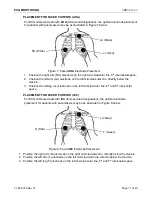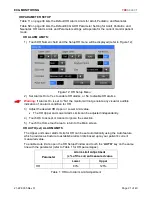
ECG MONITORING
740
SELECT
21-22-0335 Rev D
Page 24 of 40
ECG FILTER
The user-selectable
ECG Filter
feature allows the clinician to select the desired filtering of the
displayed ECG waveform.
User Selectable settings: Monitor (0.67 - 40 Hz) (Default) & Diagnostic (0.05 - 40 Hz)
CAL PULSE
The user-selectable
Cal Pulse
feature allows the clinician to insert a 1 mV pulse onto the
currently selected ECG waveform. Press the
Cal Pulse
button and then
OK
. Upon returning
to the Main screen, the pulse will be injected onto the ECG waveform (refer to Figure 14).
Note:
Pressing the
Cal Pulse
button more than once will only produce one pulse. Pressing
the
Cal Pulse
button and then the
Cancel
button will not generate a pulse. Returning to the
Main screen due to the menu inactivity timeout, will not generate a pulse.
Figure 14: ECG Cal Pulse
TESTING HR ALARMS
To manually test ECG monitoring alarm functionality on a daily basis, you may use the following
approach:
1.
Connect the monitor to an ECG Patient simulator via the 3 leads;
2.
Set the ECG Patient simulator for 1 mV ECG amplitude, HR of 80 bpm, RR of 12 rpm and
an impedance baseline of
500Ω;
3.
Enable the HR alarms;
4.
Lower the HR upper alarm limit setting below its current value;
5.
Verify that "HR < [upper limit]" annunciates as a medium level alarm;
6.
Press the ALARM SILENCE key;
7.
Return the HR upper alarm limit to its previous value; and
8.
Verify that the alarm is no longer active, and that ECG monitoring continues normally.
Repeat this steps 3-7 for the HR lower limit Test.
9.
Alternatively, disconnect the RA or LL electrode;
10. Verify that "HR lead off" annunciates as a low level alarm;
11. Press ALARM SILENCE and reconnect the electrode; and
12. Verify that the alarm is no longer active and that ECG monitoring continues normally.
The ECG
Monitoring settings and specifications may be found Section 9, SPECIFICATIONS.






























